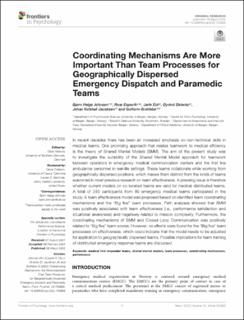| dc.contributor.author | Johnsen, Bjørn Helge | |
| dc.contributor.author | Espevik, Roar | |
| dc.contributor.author | Eid, Jarle | |
| dc.contributor.author | Østerås, Øyvind | |
| dc.contributor.author | Jacobsen, Johan Kolstad | |
| dc.contributor.author | Brattebø, Guttorm | |
| dc.date.accessioned | 2022-05-27T13:12:09Z | |
| dc.date.available | 2022-05-27T13:12:09Z | |
| dc.date.created | 2022-04-21T08:24:53Z | |
| dc.date.issued | 2022-03-08 | |
| dc.identifier.issn | 1664-1078 | |
| dc.identifier.uri | https://hdl.handle.net/11250/2996511 | |
| dc.description.abstract | In recent decades there has been an increased emphasis on non-technical skills in medical teams. One promising approach that relates teamwork to medical efficiency is the theory of Shared Mental Models (SMM). The aim of the present study was to investigate the suitability of the Shared Mental Model approach for teamwork between operators in emergency medical communication centers and the first line ambulance personnel in real-life settings. These teams collaborate while working from geographically dispersed positions, which makes them distinct from the kinds of teams examined in most previous research on team effectiveness. A pressing issue is therefore whether current models on co-located teams are valid for medical distributed teams. A total of 240 participants from 80 emergency medical teams participated in the study. A team effectiveness model was proposed based on identified team coordinating mechanisms and the “Big five” team processes. Path analyses showed that SMM was positively associated with team effectiveness (i.e., performance satisfaction and situational awareness) and negatively related to mission complexity. Furthermore, the coordinating mechanisms of SMM and Closed Loop Communication was positively related to “Big five” team scores. However, no effects were found for the “Big five” team processes on effectiveness, which could indicate that the model needs to be adjusted for application to geographically dispersed teams. Possible implications for team training of distributed emergency response teams are discussed. | en_US |
| dc.language.iso | eng | en_US |
| dc.publisher | Frontiers | en_US |
| dc.rights | Navngivelse 4.0 Internasjonal | * |
| dc.rights.uri | http://creativecommons.org/licenses/by/4.0/deed.no | * |
| dc.title | Coordinating Mechanisms Are More Important Than Team Processes for Geographically Dispersed Emergency Dispatch and Paramedic Teams | en_US |
| dc.type | Journal article | en_US |
| dc.type | Peer reviewed | en_US |
| dc.description.version | publishedVersion | en_US |
| dc.rights.holder | Copyright 2022 the authors | en_US |
| dc.source.articlenumber | 754855 | en_US |
| cristin.ispublished | true | |
| cristin.fulltext | original | |
| cristin.qualitycode | 1 | |
| dc.identifier.doi | 10.3389/fpsyg.2022.754855 | |
| dc.identifier.cristin | 2018053 | |
| dc.source.journal | Frontiers in Psychology | en_US |
| dc.identifier.citation | Frontiers in Psychology. 2022, 13, 754855. | en_US |
| dc.source.volume | 13 | en_US |

